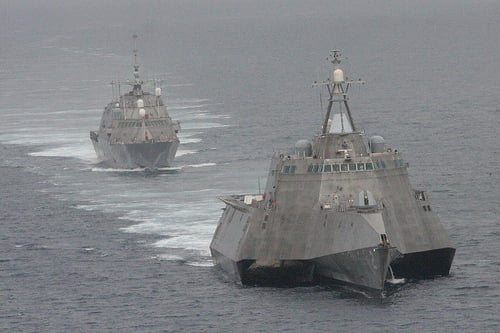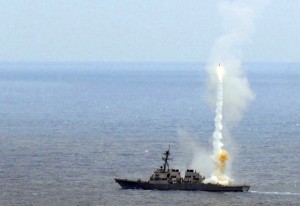
The Navy’s plan calls for a 38 percent increase in the number of attack submarine, like the Virginia-class sub USS Minnesota seen here under construction in Newport News.
WASHINGTON: Mr. Trump, we’ll see your campaign pledge of a 350-ship fleet and raise you five vessels, the US Navy effectively said this morning. The long-anticipated Force Structure Assessment calls for a fleet of 355 ships to counter “a growing China and a resurgent Russia,” Navy Secretary Ray Mabus announced today.
[Click here for Congressional reaction & expert analysis]

The new carrier USS Ford is afloat but still unfinished.
That’s almost 14 percent higher than the Navy’s previous goal of 308 ships, set back in 2014, and almost 30 percent higher than the fleet’s actual size today, 275. The largest category of growth? Nuclear-powered attack submarines, considered the stealthy capital ships of future war zones too lethal for surface vessels. This is the first increase in the goal for subs since 2004, noted a pleased Rep. Joe Courtney, top Democrat on the House seapower subcommittee, and it’s a doozy: from 48 boats to 66.
The 355-ship figure is an aspiration, not a funded budget, and it would require funding far above the Budget Control Act caps. But 355 is an aspiration with authority, grounded on the collective professional judgement of the fleet, informed by years of increasing consensus among analysts, and it will help set the terms for the budget debate.

LCS-2, USS Independence, followed by LCS-1, USS Freedom, showing the two different designs.
It’s not just the number of ships but the mix of types that shifts in the new plan. The 350-ship plan doesn’t pad the numbers with support craft and smaller warships. In fact, the target for “small surface combatants” such as frigates — which in practice means the controversial Littoral Combat Ship — stays at 52, as in past plans. Instead, the 355-ship plan is heavy on heavy hitters, adding
- one more aircraft carrier, which would increase the flattop force — the flagships of the fleet since 1941 — from 11 to 12. All aircraft carriers are built by Newport News in Virginia.
- 18 more attack submarines, arguably the capital ships of the 21st century, going from 48 to 66, a whopping 38 percent increase. Subs are built by Newport News in Virginia and Electric Boat in New England (including Courtney’s district).
- 16 more destroyers and cruisers, the workhorses of both missile defense and missile attack, going from 88 to 104 “large surface combatants,” an 18 percent increase. These ships are built by Bath Iron Works in Maine and Ingalls Shipbuilding in Pascagoula, Miss.
- four more amphibious warships to deploy Marines, from 34 to 38, a 12 percent increase. “Gators” are mainly built by Ingalls.
- and eight more support ships: two Expeditionary Support Bases (né Mobile Landing Platforms) to support Marine Corps landings, doubling the ESB force from three ships to six; three Combat Logistics Force ships to keep the fleet supplied, a modest increase from 29 to 32; and two command and support ships, an increase from 21 to 23. NASSCO in San Diego is the leading yard for support ships.
Only the extremes of the naval spectrum remain unchanged. The relatively cheap small surface combatants (e.g. LCS) remain unchanged at 52, and the immensely expensive nuclear-missile submarines (the future Columbia class) remain at 12.

Arleigh Burke-class destroyer USS Fitzgerald launches an SM-2 missile.
There’s a political backstory here. Mabus has campaigned for more ship throughout his seven years in office — an almost unprecedented tenure for a service secretary — and clashed with Defense Secretary Ash Carter and Deputy Secretary Bob Work, who think the Navy should spend more of its limited resources on upgrading the ships it has. All three men are now headed out of office, but US Naval Institute News has reported that Mabus is deliberately pitching his shipbuilding plans over Carter and Work’s heads to the incoming Trump administration.
The Office of the Secretary of Defense has accused Mabus of emphasizing quantity over quality. That conflict peaked with Carter’s order to build only 40 Littoral Combat Ships, instead of the full 52 the Navy said was necessary. The 355-ship plan stands by the 52 figure, but the growth is in high-end vessels like attack submarines and destroyers. This isn’t a shipbuilding plan driven by low-threat, day-to-day presence patrols: It’s a plan for war.
Updated 11:50 am with Rep. Courtney comment, shipyard information.
FSA Executive Summary SECNAV Final by BreakingDefense on Scribd
Major trends and takeaways from the Defense Department’s Unfunded Priority Lists
Mark Cancian and Chris Park of CSIS break down what is in this year’s unfunded priority lists and what they say about the state of the US military.


























